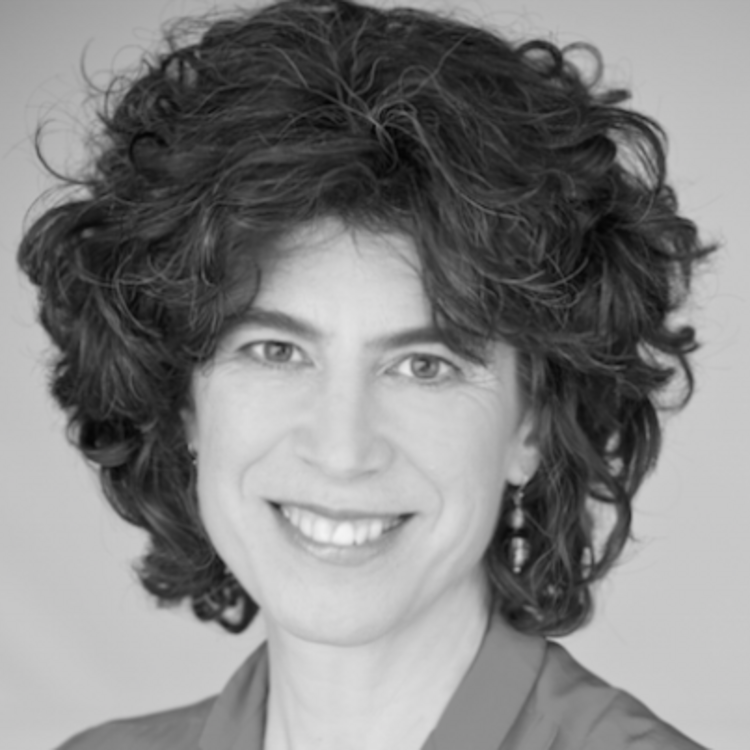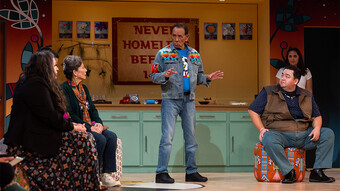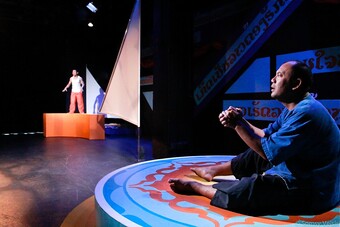Dancing is About Moving
Where do older adults fit into our world today? This question is currently one of great concern, politically, socially, and artistically. The growing field of Senior Theatre is one bold response. Through this week's series, we'll explore the many facets of this small but growing field. These stories highlight the sometimes-hidden power of the eldest members of our community, and share how much they have to offer to the world through their art. Maria Genné founded Kairos Dance Theatre (now Kairos Alive!) in 1999. She is a dancer, choreographer, educator, and a pioneer in intergenerational participatory performing arts.
Dancing is about moving. It is a language that we know in our bones, we feel its rhythm in our heartbeat, mark time with our breath and know its patterns in our complex cellular structure. Dance’s intimate partner is music and rhythm; and we find each other as partners—in circles, lines, listening to each other’s rhythm and music—by creating a dance together. Moving is about being alive.
As a dancer I invite people—older, younger, and all abilities—to join me in being part of the creative process of making dances while dancing in a circle, or dancing in a chair. This can be with an older person, a caregiver, a person with memory loss; or someone who feels lonely, or has different abilities or doesn’t think they can dance. I believe all these people are welcome in the dance circle. It is my job as a dance artist to lay a foundation of safety, accessibility, respect, and joyful collaboration so that the people I dance with are affirmed and have an opportunity to share their gifts. I call this artistic inclusivity radical inclusion. How can I invite and enable the slowest person to dance and highlight the legacy of the oldest person in the circle? How can I encourage each person’s imaginative engagement in this open-ended structure? We create a participation design so that each interaction is welcoming, collaborative, enlivening, and facilitated by experienced performing artists. We call this participatory dance, music, and story theatremaking at Kairos Alive! Choreography of Care.™
Kairos Alive! is a performing and participatory dance, music, and story theatre arts education organization, which is led by a core group of professional artists that work collaboratively, across arts disciplines and across generations. We’ve been dancing as an intergenerational performing troupe and teaching community since 1999. Dancing with others has always been my way of creating community.

In early November 2015, we were invited to bring Kairos’ Community Arts and Wellbeing Residency™ to a small town in northern Minnesota. We literally rolled out of our car into the assisted living site that had elders in chairs and wheelchairs, and visiting young adults with developmental disabilities from the Adult Day Program waiting. Our team of three Teaching Artists always begins by moving around the circle greeting each person; telling them that we are glad they are there; and making sure they are each wearing a big easily readable nametag. We get people tapping a rhythm, this time with Bobby Darin singing “Mack the Knife. Once people begin moving, tapping their foot, or finger, they begin to come alive. A few were willing to try a walking “stroll” with one of us artists to one of our favorite “walking” songs, “Sunny Side of the Street.” We borrow the tune, and sing and dance each person’s name. Then, more people begin to join us. Some people stroll in wheelchairs with a partner, some stay dancing in chairs. Soon the room is full of dancing and singing people—a community that has found its common language.
I see “Zelda” moving about in her chair—looking around, hesitant—but responding to the music and the dancing. I walk up to her and hold out my hand in invitation. We dance around the circle, greeting and smiling with others. Within a few minutes, Zelda tells me she’s from Louisiana and she “used to teach tap dance,” and she starts singing “In Them Old Cotton Fields Back Home.” She “taps” in her chair in the circle while wearing her sneakers, not tap shoes. But it doesn’t matter; we join her. Her language is dance and rhythm, and she finds others in that circle with whom to sing and dance. She tells me that she “sometimes forgets” where she is.
Later that evening, Zelda came with some of the other elder women from the assisted living facility to our first Kairos Intergenerational Dance Hall™ in a VFW club. We were a bit nervous with the bar, pool tables and the fluorescent lights. Once the two-piece band starts singing and playing, the young people start streaming in from the adult day program with their friends, caregivers, families, and a couple of retired teachers from the local school district. We also see “Dorothy”(a ninety-year old who dances all the time and drives herself), her daughter, people from town; and even six children with a smiling Mom and Dad who just moved into town from the reservation. We knew what to do: sing, dance, and share stories. We premiered our latest version of “Soul Train” with chair dancers and intergenerational dancers who boogied down the middle. Zelda was the queen of us all, “tap” dancing with Teaching Artist Nicholas. She danced every dance and I finally had to encourage her to take some of the dances “sitting down.”
It is my job as a dance artist to lay a foundation of safety, accessibility, respect, and joyful collaboration so that the people I dance with are affirmed and have an opportunity to share their gifts. I call this artistic inclusivity radical inclusion.
The next morning, we dance at the assisted living facility again. Early in the afternoon we head to the school with our three elder women friends. The fourth graders are waiting on the big stage. We all do a “Flash Mob,” while I discuss research that proves “dancing can help you be smarter and healthier.” We dance in a big circle. Then, “Martha” shows us how to whistle; “Anna” has a song; and both
Nicholas and Zelda lead all twenty-five fourth graders in several “tap” dances, and a conga line. We set three chairs in the middle of the big dancing circle for the elder women, with fourth graders sitting around them. The children are ardent, excited, impressed. “Questions?” There are several. “Do you paint?” one child asks an elder. Then, one young boy asks Zelda, “What was your fifth step?” There is a pause from the woman who told me that she has memory loss. She stands up and says to the boy, “Can I show you?” She then does a time step in her sneakers and we all learn it. She aced that moment and we all knew it.
The time has gone so quickly. The children need to go back to class. We take a picture of all of us with the elder women in the center. The elders are excitedly planning for the next time they will come to teach dance, whistling, and stories. The children hug the women, thank them, and wave goodbye.
Later at the assisted living facility we have a community meeting, brainstorming with local colleagues about how to bring creative aging to more people in the community. Zelda comes and sits beside me and says: “You know I have this thing where I can’t remember. Can you fix it?” I pause and say, “I wish I could fix it, but I can’t. But, I promise that if you keep dancing with your friends and the children, you can slow it [memory loss] down—it won’t matter so much.” I remind her that she remembers how to dance. Zelda responds, “OK, we’ll try that.”
For more information about the work of Kairos Alive! visit http://kairosalive.org/














Comments
The article is just the start of the conversation—we want to know what you think about this subject, too! HowlRound is a space for knowledge-sharing, and we welcome spirited, thoughtful, and on-topic dialogue. Find our full comments policy here
Good initiative! I wonder how is Kairos now, after 4 years? Dancing is really very useful for older people. I liked this article about the benefits of dancing for the elderly.